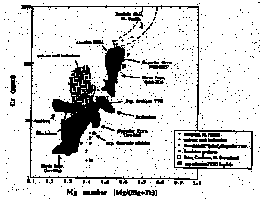
The products of island arc magmatism in hot subduction zones (e.g., where an oceanic ridge is being subducted, oceanic lithosphere is young and hot, or subduction is slow and oblique) are distinguished by geochemical characteristics that suggest the involvement, either directly or indirectly, of silica-rich partial melts of the basaltic crust of the subducted slab (Rapp and Shimizu, 1995). The term "adakite" has been applied to those members of this group of magmas that appear to be relatively uncontaminated products of slab melting (Defant and Drummond, 1990), based on comparisons with tonalite-trondhjemite-granodiorite (TTG) liquids produced in laboratory melting experiments (Rapp and Watson, 1995) on natural MORB compositions at 1-3 GPa and 900-1150°C, where residual crystalline assemblages are garnet-amphibolite or eclogite (Rapp and Watson, 1995). Ion microprobe analyses of the experimental TTG liquids for a wide range of trace elements (rare-earth elements, Ti, Zr, Sr, Y, Cr, V and Nb) reveal the following consistencies with adakite: high La/Yb, K/Nb, La/Nb, Sr/Y ratios, heavy REE and Y depletion, and high Sr and large-ion lithophile element (LILEs) abundances (Rapp and Shimizu, 1995). The experimental TTG, however, have generally low Mg# (cation ratio Fe/(Fe+Mg) < 0.4) and Cr and Ni contents, features they share with only some of the island arc magmas that have been called "adakite".
At the other end of the spectrum of magmas produced in "hot" subduction zones are high-magnesian andesites (HMA) with primitive characteristics such as high Mg#'s (> 0.5) and high Cr and Ni abundances (Yogodzinski et al., 1995). However, these HMA retain the characteristic slab-derived trace element signatures noted above (i.e., high La/Yb, K/Nb, La/Nb, Sr/Y etc....). Thus two end-member, "hot" subduction zone island arc magmas can be identified, one resembling direct TTG slab melts (with low Mg#s, and low Cr and Ni contents), and the other, with primitive features (high Mg#, high Cr and Ni) superimposed on the overall "slab melt" trace element signature. When regional data for adakites and HMA from the Circum-Pacific are considered, a complete continuum between these two end-members is apparent (Fig. 1), as a result of varying extents of reaction between slab-derived melts and mantle wedge. Geochemical modelling by Kelemen et al. (1993) has demonstrated that hybridization of slab melts by reaction with peridotite assemblages is capable of raising the Mg# and Cr and Ni contents of derivative magmas, as observed in melt inclusions from the sub-arc mantle (Schiano et al., 1995). Thus high-Mg# adakites are akin to HMA, and reflect relatively significant extents of hybridization with mantle assemblages, and low-Mg# adakites have a closer affinity to pristine slab melts, and reflect little if any interaction with wedge assemblages. Archean granitoids analagous to low-Mg# adakite (Archean TTG), and high-Mg# adakite (Archean sanukitoid suite; Shirey and Hanson, 1984) show a similar distribution across the full spectrum of Fig. 1. This suggests that early growth of the continental crust took place under conditions analagous to "hot" subduction, perhaps by convergence of oceanic plateaux and shallow subduction, obduction and imbrication of young slabs of hot Archean oceanic lithosphere.
Defant, M.J. & Drummond, M.S., Nature 347, 662-665 (1990).
Kelemen, P.B., Shimizu, N. & Dunn, T., Earth Planet. Sci. Lett. 120, 111-134 (1993).
Rapp, R.P. & Shimizu, N., submitted to Nature (1995).
Rapp, R.P. & Watson, E.B., J. Petrology 36, 891-931 (1995).
Schiano, P., Ciocchiatti, R., Shimizu, N., Maury, R.C., Jochum, K.P. & Hofmann, A.W., Nature 377, 595-600 (1995).
Shirey, S.B. & Hanson, G.N., Nature 310, 222-224 (1984).
Yogodzinski, G., Kay, R.W., Volynets, O.N., Koloskov, A.V. & Kay, S.M., GSA Bulletin 107, 509-519 (1995).
Fig. 1.